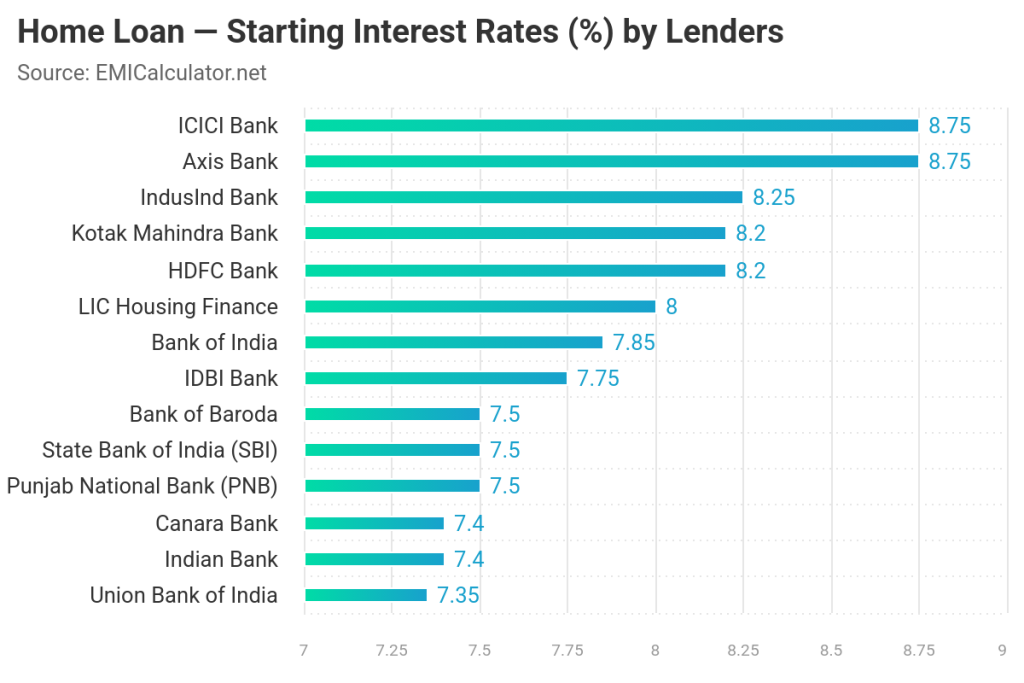
Finding your dream home is exciting; however, navigating home loan interest rates can feel like traversing a complex web. Fear not, aspiring homeowners! This guide displays current interest rates on home loans aggregated from the top lenders (Banks and HFCs) and provides a “bird’s-eye view” of the interest rates which can act as a starting point for a deep dive into various options available to you as a borrower. The starting interest rate refers to the lowest possible interest rate a lender can offer for their home loan product or scheme. It helps to understand the potential best-case scenario by knowing the actual minimum rate a lender could offer to qualified borrowers and aids comparison of various lenders’ home loan products.
Interest rate that is finally offered on your home loan will depend on various factors.
Benchmark Rates and Bank Spreads
All the home loans sanctioned by banks since October 2019 must be linked to an external benchmark — External Benchmark Lending Rate (EBLR). Hence, your loan interest rate will be EBLR + Spread. Most banks use the RBI Repo Rate as the benchmark. Your home loan interest rate will move in tandem with the benchmark rate, ensuring transparency and fairness. A rising repo rate translates into higher rates for new loans and higher EMI for existing loans. Conversely, a falling repo rate can lead to lower home loan rates.
Housing finance companies (HFCs), such as LIC Housing, use an internal benchmark — Lender’s Home Purchase Loan Rate (LHPLR) — to determine interest rates. A common issue with such benchmarks is that the lenders revise internal benchmarks quickly when the interest rates go up, but are not keen to adjust these downwards when the rates go down. Hence, the borrowers do not get the full benefit of rate cuts and would feel short-changed.
Personal Factors and Choices
Your credit score, loan amount, tenure, income, and property type directly influence your personal eligibility and interest rate. A strong credit score and stable income earn you favour in the eyes of lenders, potentially securing lower rates. Higher loan amounts and riskier groups attract a higher spread over the repo rate. Higher Loan-To-Value ratio (LTV) generally results in higher interest rates. A larger down payment reduces the loan amount needed and can improve your loan eligibility (FOIR), potentially leading to a lower interest rate.
Home loan balance transfers, resales, ready-to-move-in homes, and builder tie-up projects often attract lower rates and processing fee waivers.
Related Reading: What Percentage of Income Can Go Towards Home Loan EMI?
Borrower Segments
- Salaried vs. Self-employed: Salaried individuals often enjoy lower rates due to perceived income stability.
- Women: Some lenders offer special schemes or lower rates for women borrowers to promote financial inclusion.
- Government Employees benefit from preferential treatment, securing significantly lower rates due to stable income and job security. The government of India (GOI) also implements initiatives like the House Building Advance (HBA) scheme with concessional rates for central government employees.
- Dedicated home loan schemes for Defence Personnel offer significant concessions like lower rates, waived fees, longer tenure, moratorium period, no prepayment penalty etc. Ex: Baroda Yoddha, SBI Shaurya etc.
- Banks may offer their existing customers and salary account holders preferential interest rates and fast-track processing on home loans.
- First time homebuyers can benefit from dedicated schemes like Credit Linked Subsidy Scheme (CLSS) under PMAY.
Fixed vs. Floating Interest Rate Home Loans
- Fixed rates: Fixed rate loans result in predictable EMIs throughout the loan tenure, but potentially higher initial rates and missed savings if rates fall. Pre-closure and prepayment penalties could apply. Banks may offer fixed rate only for a certain number of months or the entire tenure. For longer duration “fixed rate”, the difference between floating rate and fixed rate widens. When compared to floating interest rates, fixed home loan rates tend to be higher by about 1-2.5%.
- Floating rates: Typically lower rates (compared to fixed rate loans), but susceptible to rate revisions based on the external benchmark rate fluctuations. RBI does not permit pre-closure and prepayment charges on such variable rate loans.
Related Reading: Fixed Rate vs. Floating Rate Loan
Lenders sometimes run special campaigns, offering lower rates and fee waivers, during festive seasons or for first-time homebuyers. Keep an eye out for such limited period offers.
Processing fees and other charges: While not directly impacting the interest rate, some lenders may charge additional fees for processing, documentation, or prepayment, which can impact the overall cost of the loan.
Finally, beware if you are offered loan at too attractive an interest rate.
Always compare rates from different lenders and explore your eligibility under various schemes before making a decision. Consult financial advisors and ask your lender plenty of questions. With the right knowledge, you will find your perfect home loan partner and make your dream home a reality!
Happy home buying!